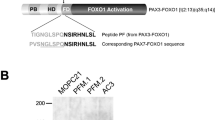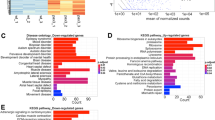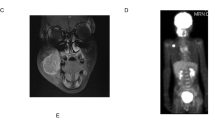Abstract
Rhabdomyosarcoma has 2 major histological subtypes, embryonal and alveolar. Alveolar histology is associated with the fusion genes PAX3-FKHR and PAX7-FKHR. Definition of alveolar has been complicated by changes in terminology and subjectivity. It is currently unclear whether adverse clinical behaviour is better predicted by the presence of these fusion genes or by alveolar histology. We have determined the presence of the PAX3/7-FKHR fusion genes in 91 primary rhabdomyosarcoma tumours using a combination of classical cytogenetics, FISH and RT-PCR, with a view to determining the clinical characteristics of tumours with and without the characteristic translocations. There were 37 patients with t(2;13)/PAX3-FKHR, 8 with t(1;13) PAX7-FKHR and 46 with neither translocation. One or other of the characteristic translocations was found in 31/38 (82%) of alveolar cases. Univariate survival analysis revealed the presence of the translocation t(2;13)/PAX3-FKHR to be an adverse prognostic factor. With the difficulties in morphological diagnosis of alveolar rhabdomyosarcoma on increasingly used small needle biopsy specimens, these data suggest that molecular analysis for PAX3-FKHR will be a clinically useful tool in treatment stratification in the future. This hypothesis requires testing in a prospective study. Variant t(1;13)/PAX7-FKHR appears biologically different, occurring in younger patients with more localised disease. © 2001 Cancer Research Campaign http://www.bjcancer.com
Similar content being viewed by others
Article PDF
Change history
16 November 2011
This paper was modified 12 months after initial publication to switch to Creative Commons licence terms, as noted at publication
References
Anderson J, Renshaw J, McManus A, Carter R, Mitchell C, Adams S and Pritchard-Jones K (1997) Amplification of the t(2; 13) and t(1; 13) translocations of alveolar rhabdomyosarcoma in small formalin-fixed biopsies using a modified reverse transcriptase polymerase chain reaction. Am J Pathol 150: 477–482
Bennicelli JL, Fredericks WJ, Wilson RB, Rauscher FJ 3rd and Barr FG (1995) Wild type PAX3 protein and the PAX3-FKHR fusion protein of alveolar rhabdomyosarcoma contain potent, structurally distinct transcriptional activation domains. Oncogene 11: 119–130
Biegel JA, Nycum LM, Valentine V, Barr FG and Shapiro DN (1995) Detection of the t(2;13)(q35;q14) and PAX3-FKHR fusion in alveolar rhabdomyosarcoma by fluorescence in situ hybridization. Genes Chromosomes Cancer 12: 186–192
Bown NP, Reid MM, Malcolm AJ, Davison EV, Craft AW and Pearson AD (1994) Cytogenetic abnormalities of small round cell tumours. Med Pediatr Oncol 23: 124–129
Crist W, Gehan EA, Ragab AH, Dickman PS, Donaldson SS, Fryer C, Hammond D, Hays DM, Herrmann J and Heyn R et al (1995) The Third Intergroup Rhabdomyosarcoma Study. J Clin Oncol 13: 610–630
Crist WM, Garnsey L, Beltangady MS, Gehan E, Ruymann F, Webber B, Hays DM, Wharam M and Maurer HM (1990) Prognosis in children with rhabdomyosarcoma: a report of the intergroup rhabdomyosarcoma studies I and II. Intergroup Rhabdomyosarcoma Committee [see comments]. J Clin Oncol 8: 443–452
Davis RJ, D’Cruz CM, Lovell MA, Biegel JA and Barr FG (1994) Fusion of PAX7 to FKHR by the variant t(1;13)(p36;q14) translocation in alveolar rhabdomyosarcoma. Cancer Res 54: 2869–2872
Douglass EC, Shapiro DN, Valentine M, Rowe ST, Carroll AJ, Raney RB, Ragab AH, Abella SM and Parham DM (1993) Alveolar rhabdomyosarcoma with the t(2;13): cytogenetic findings and clinicopathologic correlations. Med Pediatr Oncol 21: 83–87
Downing JR, Khandekar A, Shurtleff SA, Head DR, Parham DM, Webber BL, Pappo AS, Hulshof MG, Conn WP and Shapiro DN (1995) Multiplex RT-PCR assay for the differential diagnosis of alveolar rhabdomyosarcoma and Ewing’s sarcoma. Am J Pathol 146: 626–634
Galili N, Davis RJ, Fredericks WJ, Mukhopadhyay S, Rauscher FJD, Emanuel BS, Rovera G and Barr FG (1993) Fusion of a fork head domain gene to PAX3 in the solid tumour alveolar rhabdomyosarcoma [published erratum appears in Nat Genet 1994 Feb; 6(2): 214]. Nat Genet 5: 230–235
Gordon AT, McManus A, Anderson J, Min T, Swansbury J, Pritchard-Jones K and Shipley J (2001) Cytogenetic Abnormalities in 42 Rhabdomyosarcoma. A United Kingdom Cancer Cytogenetics Group Study. Med Ped Oncol 36: 259–267
Kelly KM, Womer RB, Sorensen PH, Xiong QB and Barr FG (1997) Common and variant gene fusions predict distinct clinical phenotypes in rhabdomyosarcoma. J Clin Oncol 15: 1831–1836
McManus AP, Min T, Swansbury GJ, Gusterson BA, Pinkerton CR and Shipley JM (1996a) der(16)t(1;16)(q21;q13) as a secondary change in alveolar rhabdomyosarcoma. A case report and review of the literature. Cancer Genet Cytogenet 87: 179–181
McManus AP, O’Reilly MA, Jones KP, Gusterson BA, Mitchell CD, Pinkerton CR and Shipley JM (1996b) Interphase fluorescence in situ hybridization detection of t(2;13)(q35;q14) in alveolar rhabdomyosarcoma–a diagnostic tool in minimally invasive biopsies. J Pathol 178: 410–414
Pinkerton CR, Groot-Loonen J, Barrett A, Meller ST, Tait D, Ashley S and McElwain TJ (1991) Rapid VAC high dose melphalan regimen, a novel chemotherapy approach in childhood soft tissue sarcomas. Br J Cancer 64: 381–385
Roberts P, Browne CF, Lewis IJ, Bailey CC, Spicer RD, Williams J and Batcup G (1992) 12q13 abnormality in rhabdomyosarcoma. A nonrandom occurrence?. Cancer Genet Cytogenet 60: 135–140
Scrable H, Witte D, Shimada H, Seemayer T, Sheng WW, Soukup S, Koufos A, Houghton P, Lampkin B and Cavenee W (1989) Molecular differential pathology of rhabdomyosarcoma. Genes Chromosomes Cancer 1: 23–35
Tsokos M, Webber BL, Parham DM, Wesley RA, Miser A, Miser JS, Etcubanas E, Kinsella T, Grayson J and Glatstein E et al (1992) Rhabdomyosarcoma. A new classification scheme related to prognosis. Arch Pathol Lab Med 116: 847–855
Valentine M, Douglass EC and Look AT (1989) Closely linked loci on the long arm of chromosome 13 flank a specific 2;13 translocation breakpoint in childhood rhabdomyosarcoma. Cytogenet Cell Genet 52: 128–132
Weber-Hall S, McManus A, Anderson J, Nojima T, Abe S, Pritchard-Jones K and Shipley J (1996) Novel formation and amplification of the PAX7-FKHR fusion gene in a case of alveolar rhabdomyosarcoma. Genes Chromosomes Cancer 17: 7–13
Yule SM, Bown N, Malcolm AJ, Reid MM and Pearson AD (1995) Solid alveolar rhabdomyosarcoma with a t(2;13). Cancer Genet Cytogenet 80: 107–109
Author information
Authors and Affiliations
Consortia
Rights and permissions
From twelve months after its original publication, this work is licensed under the Creative Commons Attribution-NonCommercial-Share Alike 3.0 Unported License. To view a copy of this license, visit http://creativecommons.org/licenses/by-nc-sa/3.0/
About this article
Cite this article
Anderson, J., Gordon, T., McManus, A. et al. Detection of the PAX3-FKHR fusion gene in paediatric rhabdomyosarcoma: a reproducible predictor of outcome?. Br J Cancer 85, 831–835 (2001). https://doi.org/10.1054/bjoc.2001.2008
Received:
Revised:
Accepted:
Published:
Issue date:
DOI: https://doi.org/10.1054/bjoc.2001.2008
Keywords
This article is cited by
-
Oncogenic role of HMGA2 in fusion-negative rhabdomyosarcoma cells
Cancer Cell International (2020)
-
OLIG2 is a novel immunohistochemical marker associated with the presence of PAX3/7-FOXO1 translocation in rhabdomyosarcomas
Diagnostic Pathology (2019)



